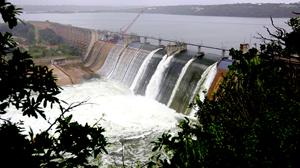Landowners oppose Wichita Falls proposal to build $443 million reservoir to support North Texas water needs
HENRIETTA, Texas (AP) — Last year, residents traveled to Austin, The Texas Tribune reported, to voice their opposition to a 16,000-acre reservoir that the city of Wichita Falls wants to build in Clay County, approximately 30 miles east of the city.

City leaders have applied for a state permit, arguing that building Lake Ringgold is vital to help the city avoid running out of water during droughts, which climate change has made more common and more intense.
The Texas Commission on Environmental Quality, the state’s environmental agency, will vote on the city’s permit on Friday.
If the city is granted the state water rights permit from TCEQ, it would next need to apply for a permit with the U.S. Army Corps of Engineers; the city needs both a state permit and a federal permit for the project.
The seeds for the Lake Ringgold plan began about three years after Russell Schreiber took a job as the director of public works for Wichita Falls in 2008.
A severe drought struck the area in 2010 and lingered for years, nearly draining the city’s two reservoirs: Lake Kickapoo and Lake Arrowhead. Schreiber faced the nearly impossible task of finding water during one of the worst droughts to ever hit North Texas.
“It was very devastating,” Schreiber said, remembering how Lake Arrowhead, the city’s primary water reservoir, and its other reservoirs came close to drying up.
When Wichita Falls hit a Stage 5 drought, the highest of the stages that’s considered a “drought catastrophe,” the city issued water restrictions banning all nonessential water use like refilling swimming pools, using sprinkler systems and washing cars.
From July 2014 to July 2015, the city tried something new: direct potable reuse, a water recycling process that purifies waste and sewer water using a filtration system. The system allows the filtered water to be immediately used as drinking water.
Schreiber said at the time the city exhausted nearly every option to reduce water use, and managed to reduce the demand on the two reservoirs by 75%. But it wasn’t enough, and the reservoirs reached an all-time low of 20% of capacity.
This prompted city officials to dust off plans for a new reservoir that’s been considered since the 1950s.
“We’re the only water supply for the whole North Texas region,” Schreiber said, referring to nearby communities like Olney, Burkburnett, Electra and a dozen others that get water from the same reservoirs. “And it’s our job to ensure that there’s adequate supply for this region.”
After the drought finally ended in 2017, the city applied for a water rights permit with the state to build the Lake Ringgold reservoir.
The reservoir would be formed by building a dam on the Little Wichita River approximately half a mile upstream from its confluence with the Red River and downstream from Lake Kickapoo and Lake Arrowhead.
The reservoir would cost $443 million to build and could hold 65,000 acre-feet of water per year. (An acre-foot of water is enough to cover one acre to a depth of one foot.)
The city would need 24,000 acres of land for the reservoir site, which includes the lake, pump station facilities and transmission line to send water to treatment facilities in Wichita Falls.
The city owns approximately 6,662 acres of the land needed for the reservoir, but would still need to acquire the remaining land through purchase or eminent domain.
Opponents of the project say it would force more than 25 Texas ranching families to sell all or part of the land.
After the TCEQ issued a draft permit for Lake Ringgold in 2019, local residents, along with environmental groups like the Texas Conservation Alliance, disputed that decision, which triggered the contested case hearing — a formal legal proceeding where parties present evidence and arguments regarding a specific environmental permit application.
At the hearing, they argued that Lake Ringgold would harm agriculture in the area and force landowners to sell the city their land.
After the hearing, the judge recommended that the TCEQ deny the city’s request to build Lake Ringgold, saying the project was too big for what the city’s shrinking population needed.
While the city has projected a population increase to 120,000 by 2070, Wichita Falls’ population has dropped from 104,000 to 102,000 since 2010, according to the latest U.S. Census.
Meanwhile, Schreiber, the public works director, defended the proposed reservoir project.
“If I’ve got two glasses of water half full sitting on the table, I’ve got a certain amount of water to use, right?” Schreiber said. “If I’ve got three glasses of water half full, I’ve got more water to use, right?
“That’s the reason reservoirs are built,” Schreiber added. “They’re built to store floodwaters for use later. You dam up the river and you create an impoundment that stores that water for people to use at a later time.”
Related News
From Archive

- DeLa Express seeks FERC approval for Permian-to-Louisiana gas pipeline project
- Hudson Tunnel Project set to generate 95,000 jobs during construction phase, report says
- Boring machine 'Chessie' resumes drilling at Chesapeake Bay Bridge-Tunnel site after anchor incident
- Charleston Water System settles huge lawsuit over sewer system damage caused by non-flushable wipes
- Aegion continues western expansion with acquisition of underground utilities company Toncco
- Ditch Witch 1030
- 24th Annual Directional Drilling Survey
- Michigan lawmakers introduce bills to create septic codes throughout the state
- House passes Rep. Duarte's legislation to streamline water permitting processes in the Valley
- Court approves 3M settlement over ‘forever chemicals’ in public drinking water systems



Comments